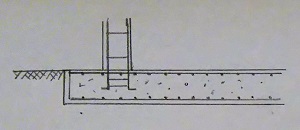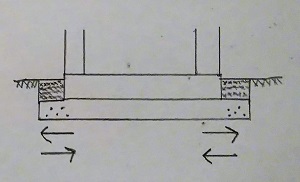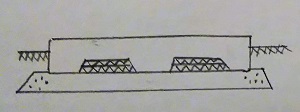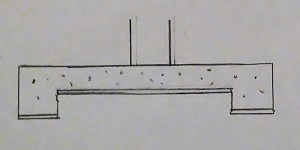Types of raft foundation
Contents |
[edit] Introduction
Foundations provide support for structures, transferring their load to layers of soil or rock that have sufficient bearing capacity and suitable settlement characteristics to support them.
Very broadly, foundations can be categorised as shallow foundations or deep foundations:
- Shallow foundations are typically used where the loads imposed by a structure are low relative to the bearing capacity of the surface soils.
- Deep foundations are necessary where the bearing capacity of the surface soils is not adequate to support the loads imposed by a structure and so those loads need to be transferred to deeper layers with higher bearing capacity.
Raft foundations are a type of shallow foundation. They are typically formed by reinforced concrete slabs that cover a wide area, often the entire footprint of a building. They spread the load imposed by a number of columns, walls, and so on, over a large area, and can be considered to ‘float’ on the ground in a similar way to a raft floating on water. Also known as mat foundations, they are often used for lightly-loaded buildings on weak or expansive soils such as clays or peat.
There are several different types of raft foundation, which are selected depending upon the structural system and loads to be supported.
[edit] Solid slab raft
[edit] Flat raft mat
This is a reinforced concrete slab of uniform thickness covering the whole bearing area. This can be used when columns are positioned at equal distance with equal loads distributed on the foundation. Two steel meshes are generally used as reinforcement, one placed at the bottom of the slab and the other at the top, to counteract upward and downward bending forces.
Flat raft mats are commonly used for the construction of small dwellings.
Generally, top soil is removed and a 50-75 mm-thick blinding layer of concrete spread to provide a base. It is on this base that the concrete raft is cast. With the blinding dry, the damp proof membrane is laid to protect the raft from rising moisture causing damage. The reinforcement is positioned and the concrete poured and consolidated.
In terms of finishing, it can be poured to ground level or left just below the surface. A 50 mm-thick layer of concrete can be spread over the raft to raise the level, providing a smooth finish for floor coverings to be laid. Alternatively, if the floor needs to be raised above ground, a raised floor may be constructed on top of the raft surface.
[edit] Wide toe raft
This type of solid slab is used where the poor compressibility of the ground would necessitate an uneconomically thick slab. To take the load at the external leaf of cavity walls, a reinforced concrete toe extends as a base. This is cast from a stiffening edge beam, and is typically taken to a minimum depth of 750 mm. The shape of the extended toe allows the external brick outer leaf of the cavity wall to be finished below ground.
[edit] Slip plane raft
This type of raft foundation involves a slip plane layer (usually made of sand) positioned between the raft and the sub-strata. The slip plane layer extends out beyond the raft, and the space between the surface and the slip plane is filled with a compressible material.
The slip plane should be of sufficient thickness to resist tensile or compressive ground strains, as well as accommodating potential frost heave.
[edit] Blanket raft
This type of raft is used to achieve a composite action that can disperse edge loads or imbalanced loads. It involves a stone blanket layer being built up from the reduced sub-strata level. This can be built up in localised soft spots or depressions. The concrete raft is poured on top of the blanket, . The interaction of the raft and blanket helps span the loading over the particularly weak areas.
[edit] Slab beam raft
This type of raft foundation is typically used where there are unequally-distributed column loads. Reinforced concrete or steel columns are positioned on intersections of reinforced concrete ground beams, which add the required stiffness to the slab.
Although it is usual for the raft to span over the ground beams, they can also be designed as upstand beams with a precast concrete suspended floor at ground level. This then creates a void between the raft and the ground floor.
[edit] Cellular raft foundation
This type of raft foundation consists of two slabs with two-way interlocking ground beams. The upper (suspended) slab and the lower (ground bearing) slab are usually incorporated within the beams to form I-sections, with voids between them.
Cellular raft foundations are very rigid, making them suitable for heavy loads or loose soil that can be subject to uneven settlement. They are commonly found on sites that have been used for heavy mining activity or in poor ground where large bending moments need to be resisted.
For more information, see Cellular raft foundation.
[edit] Piled raft foundation
Where a raft foundation may not satisfy the design requirements, it can be enhanced by the addition of piles, creating what is known as a piled raft foundation. This can improve the performance of the foundation in reducing the amount of settlement and differential settlement, as well as improving the ultimate load capacity. Piled raft foundations are an increasingly popular choice for high-rise buildings.
For more information, see Piled raft foundation.
[edit] Find out more
[edit] Related articles on Designing Buildings Wiki
Featured articles and news
Homes England supports Greencore Homes
42 new build affordable sustainable homes in Oxfordshire.
Zero carbon social housing: unlocking brownfield potential
Seven ZEDpod strategies for brownfield housing success.
CIOB report; a blueprint for SDGs and the built environment
Pairing the Sustainable Development Goals with projects.
Types, tests, standards and fires relating to external cladding
Brief descriptions with an extensive list of fires for review.
Latest Build UK Building Safety Regime explainer published
Key elements in one short, now updated document.
UKGBC launch the UK Climate Resilience Roadmap
First guidance of its kind on direct climate impacts for the built environment and how it can adapt.
CLC Health, Safety and Wellbeing Strategy 2025
Launched by the Minister for Industry to look at fatalities on site, improving mental health and other issues.
One of the most impressive Victorian architects. Book review.
Common Assessment Standard now with building safety
New CAS update now includes mandatory building safety questions.
RTPI leader to become new CIOB Chief Executive Officer
Dr Victoria Hills MRTPI, FICE to take over after Caroline Gumble’s departure.
Social and affordable housing, a long term plan for delivery
The “Delivering a Decade of Renewal for Social and Affordable Housing” strategy sets out future path.
A change to adoptive architecture
Effects of global weather warming on architectural detailing, material choice and human interaction.
The proposed publicly owned and backed subsidiary of Homes England, to facilitate new homes.
How big is the problem and what can we do to mitigate the effects?
Overheating guidance and tools for building designers
A number of cool guides to help with the heat.
The UK's Modern Industrial Strategy: A 10 year plan
Previous consultation criticism, current key elements and general support with some persisting reservations.
Building Safety Regulator reforms
New roles, new staff and a new fast track service pave the way for a single construction regulator.



























Comments
Who do I make reference to.